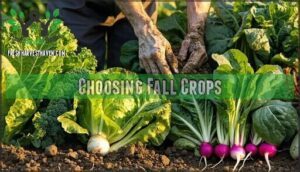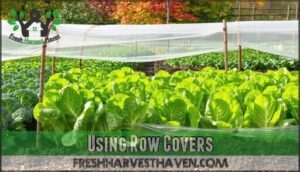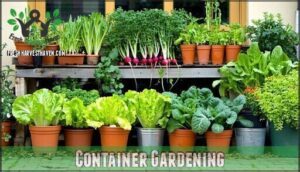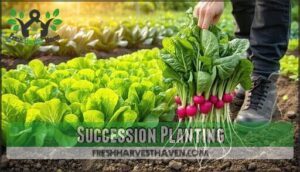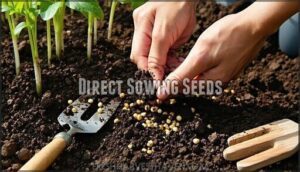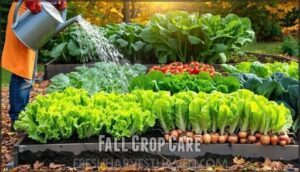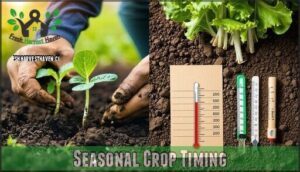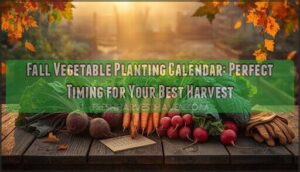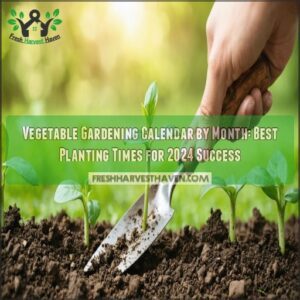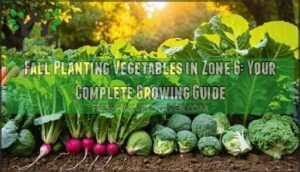This site is supported by our readers. We may earn a commission, at no cost to you, if you purchase through links.
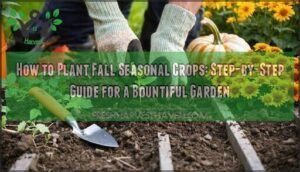 Last summer, I watched my neighbor’s fall garden produce crisp lettuce and sweet carrots well into November while mine shriveled after the first frost. The difference? She’d counted backward from her frost date and planted at exactly the right time.
Last summer, I watched my neighbor’s fall garden produce crisp lettuce and sweet carrots well into November while mine shriveled after the first frost. The difference? She’d counted backward from her frost date and planted at exactly the right time.
Planting fall seasonal crops isn’t about tossing seeds in the ground when summer ends—it’s about working with the calendar and choosing vegetables that actually enjoy cooler weather. With proper timing and a few cold-hardy varieties, you’ll harvest fresh produce long after your neighbors have given up on their gardens.
Table Of Contents
- Key Takeaways
- Fall Garden Planning
- Choosing Fall Crops
- Planting Techniques
- Fall Crop Care
- Seasonal Crop Timing
- Frequently Asked Questions (FAQs)
- How to plant vegetables in the fall?
- How do I plant cool season crops in the fall?
- Which vegetables grow best in the fall?
- When should I plant seeds for my Fall Garden?
- When is the best time to plant a fall garden?
- Are fall vegetables a good time to grow?
- What crops should be planted in the fall?
- When should I start my fall garden?
- Is September too late to plant fall vegetables?
- Are there any crops you can plant in October?
- Conclusion
Key Takeaways
- Fall planting success hinges on counting backward from your first frost date, adding each crop’s days to maturity plus two extra weeks to account for slower growth in shorter autumn days.
- Cold-hardy vegetables like kale, broccoli, spinach, and root crops not only survive frost but actually taste sweeter after exposure to cold temperatures, making them ideal fall garden choices.
- Using row covers, mulch, and proper soil preparation with compost creates the temperature regulation and moisture retention needed to extend your harvest well into winter.
- Quick-maturing crops like radishes, lettuce, and arugula can be succession planted every 10-14 days throughout fall to ensure a continuous supply of fresh vegetables for months.
Fall Garden Planning
Getting your fall garden started begins with a bit of strategy and timing. Before you grab your seeds, let’s talk about the key steps to set you up for success.
Here’s how to get your plot in shape for autumn’s cool and productive stretch.
Determining First Frost Dates
Ever wonder how chilly nights sneak up and catch your garden off guard? That’s the drama of the first frost date—one day your greens are thriving, the next, you’re mourning wilted leaves. Identifying frost dates isn’t about guessing; it’s about harnessing reliable data sources and considering your garden’s unique microclimate influence. Tools like the Old Farmer’s Almanac use historical trends, zip codes, and zone hardiness data to pin down the first expected frost date for your area, giving your crops a fighting chance. Don’t let a poor guess cost you your harvest!
- Heartbreak: losing a bed of carrots overnight
- Regret: guessing instead of checking real numbers
- Relief: knowing you beat the frost
- Satisfaction: every day your veggies thrive longer
Adjusting Planting Times
Now that your frost date is locked in, it’s time to get crafty with your calendar—so your crops don’t have to race the cold unprepared. Start with each vegetable’s days to maturity, subtract them from your expected first frost date, and tack on two bonus weeks for shorter autumn days.
| Vegetable | Timing Fall Planting | Frost Date Impact |
|---|---|---|
| Spinach | 8 weeks before frost | Quick, tolerates cold |
| Carrots | 10-12 weeks before frost | Matures slow in fall |
| Kale | 6-8 weeks before frost | Improves in frost |
| Radish | 4-6 weeks before frost | Grows fast, shallow roots |
| Broccoli | 12 weeks before frost | Needs time, loves chill |
Savvy gardeners factor in hardiness zone adjustments, microclimate considerations, and succession planting for a bountiful, extended harvest.
Preparing Soil for Fall
Once you’ve got your fall planting dates mapped out, it’s time to roll up your sleeves and give your soil the tune-up it needs for a fresh round of veggies. Sprinkle in compost and organic fertilizer to boost nutrient levels, especially nitrogen needs after summer crops.
A layer of mulch helps stabilize soil temperature and trap moisture. Consistent watering and proper soil amendments make all the difference for thriving autumn greens.
Choosing Fall Crops
Picking the right crops for your fall garden is all about working with the season, not against it. Some vegetables love the cooler weather and thrive when summer has faded.
Let’s look at the best options to plant for a harvest that keeps on giving.
Cold-Tolerant Vegetables
Have you ever noticed how some vegetables seem to wear a winter coat and thrive when the rest shiver? That’s the beauty of cold-hardy vegetables. Fall planting lets you enjoy cool-season crops with nutrient density and even sweeter flavors—thanks to a little frost-sweetening magic.
Cold-hardy vegetables don’t just tolerate frost—they thrive in it, turning sweeter and more flavorful when winter arrives
Try these rugged winners:
- Kale—withstands deep chills, growing even after a dusting of snow.
- Broccoli—produces tight heads as days shorten.
- Spinach—survives with basic overwintering techniques.
- Beets—roots and tender greens show extreme tolerance and regional suitability.
Ready to outlast the cold together? You can even plant these for a winter vegetable harvest.
Quick-Maturing Options
If you’re staring down the calendar and wondering what to grow before the chill sets in, fall gardening is still well within reach. Search for no other than fast-growing greens like arugula, quick radish varieties, turnip greens, and speedy spinach harvests—these quick-maturing vegetables thrive in an autumn planting. Fall peas also squeeze in before frost. To guarantee a successful harvest, it’s important to know your first frost date.
Here’s a rundown for your fall crop planting schedule:
| Crop | Days to Harvest | Fall Planting Tip |
|---|---|---|
| Radish Varieties | 25-30 | Succession sow every week |
| Turnip Greens | 35-40 | Sow direct, keep moist |
| Spinach Harvest | 30-40 | Use row cover for boost |
| Fall Peas | 50-60 | Choose early bush types |
| Fast-Growing Greens | 25-35 | Stagger plantings |
Frost-Tolerant Brassicas
When frost threatens your garden, brassicas are the tough customers you want on your side. These cool-season vegetables don’t just tolerate cold—they actually taste better after a light freeze sweetens them up. Fall planting of frost-tolerant varieties means you’ll harvest crisp, flavorful produce well into winter, and with proper pest control and cabbage care, you’re looking at a reliable crop that laughs at chilly nights.
- Kale varieties like ‘Winterbor’ and ‘Redbor’ survive down to 10°F and keep producing tender leaves
- Brussels sprouts need transplanting in fall for winter harvest, developing sweeter flavor after frost
- Cabbage care requires consistent moisture and row covers to protect against cabbage moths during fall gardening
- Broccoli types such as ‘Calabrese’ produce compact heads in cooler conditions without bolting
- Pest control becomes easier in autumn as many insects slow down, though row covers still help with sneaky moths
Planting Techniques
Getting your fall crops in the ground doesn’t have to be complicated, but a few smart techniques can make all the difference between a sluggish garden and a thriving one. The right approach depends on what you’re growing, your climate, and how much space you’re working with.
Let’s walk through some practical methods that’ll help your fall garden succeed.
Using Row Covers
Think of row covers as a cozy quilt for your vegetables—they’ll shield tender greens from surprise cold snaps while keeping sneaky pests at bay. These lightweight fabrics offer dual-purpose pest protection and temperature regulation, trapping warmth while allowing 70-85% light transmission for healthy growth.
For fall gardening success with cool-season crops, drape covers over hoops or frames, securing edges with soil or stakes to prevent wind damage. Choose medium-weight fabric for best frost protection—it’ll add 4-6°F of warmth during chilly nights, extending the growing season well into winter.
Container Gardening
When ground space runs out, pots and containers step in to save your fall harvest—no digging required. Container gardening lets you grow cool-season vegetables anywhere—patios, balconies, even sunny windowsills—with smart choices about vessel selection and soil preparation.
For successful fall planting, focus on these essentials:
- Container size matters: Lettuce needs 6-8 inches depth, while carrots and beets require 12+ inches for proper root development
- Drainage solutions: Add holes to any pot and layer pebbles at the bottom to prevent waterlogged roots
- Potting mixes: Choose quality blends designed for vegetable varieties—they retain moisture better than garden soil
Consider vertical gardening for vining peas, maximizing sunlight needs while conserving space.
Succession Planting
Instead of planting everything at once and hoping for the best, you can stagger your sowings like a seasoned gardener and harvest fresh greens for weeks on end. Succession planting techniques involve sowing fast-growing crops like lettuce, spinach, or radishes every 10-14 days throughout fall.
This staggered planting approach ensures a continuous supply of fresh vegetables as earlier plantings mature. By extending harvest times through careful crop rotation and maximizing yields with a smart planting schedule, you’ll enjoy fresh fall garden planting well into winter.
Direct Sowing Seeds
You don’t need a greenhouse or fancy equipment to get fall seeds started—just good soil and the right timing.
Direct sow seeds about twice as deep as spring planting to reach moist, cooler soil layers where germination rates improve. Press seeds firmly for good soil contact, then water gently to avoid washing them away.
Your watering schedule should keep soil consistently damp until sprouts appear—usually within a week when soil temperature stays around 70°F for most fall crops.
Fall Crop Care
Once your fall crops are in the ground, they still need attention to thrive and produce that bountiful harvest you’re hoping for. The cooler weather changes how you approach watering, feeding, and gathering your vegetables.
Let’s walk through the key care practices that’ll keep your autumn garden productive from planting through storage.
Consistent Watering
Proper watering often makes the difference between a thriving fall garden and one that limps along struggling to produce. Fall seedlings dry out quickly despite cooler air, so consistent watering becomes your secret weapon for crop success. Here’s your moisture management game plan:
- Check soil moisture daily by sticking your finger two inches deep into the ground
- Water deeply but less frequently to encourage strong root development and drought resistance
- Apply mulch around plants for enhanced moisture retention and weed suppression
- Monitor weather patterns and adjust watering frequency as temperatures drop
Fertilizing Fall Crops
While water keeps those fall seedlings growing strong, feeding them the right nutrients at the right time sets the stage for a truly abundant harvest. Your fall crops crave phosphorus and potassium to build sturdy roots and weather-resistant foliage. Organic fertilizers work wonders here—think compost, bone meal, and kelp.
Soil testing reveals nutrient levels before you plant, helping you avoid deficiency symptoms like yellowing leaves. Time your fertilizing about six weeks before frost, focusing on nitrogen for leafy greens and balanced blends for roots.
| Nutrient Needs | Organic Options |
|---|---|
| Phosphorus (root development) | Bone meal, rock phosphate |
| Potassium (cold hardiness) | Kelp meal, wood ash |
| Nitrogen (leafy growth) | Composted manure, blood meal |
| Balanced nutrition | All-purpose compost |
Smart soil preparation means you’re not guessing—you’re giving your garden exactly what it needs.
Harvesting Root Crops
Once you’ve nurtured your fall crops with the right nutrients, the real reward comes when you pull those roots from the earth—and knowing when they’re ready makes all the difference. Harvest timing depends on size and frost exposure—carrots and beets need firm shoulders, while parsnips actually sweeten after light frost.
Gently brush away soil moisture to check progress, use proper tools like a garden fork to avoid pest damage, and harvest before hard freezes threaten your autumn harvests.
Storing Fall Harvests
After harvesting those perfect roots, the clock starts ticking—and how you store them determines whether you’re eating garden-fresh carrots in February or tossing out mushy disappointments by December. Cool storage with humidity control is your secret weapon for preserving methods that extend shelf life through winter. Most root cellars or unheated basements maintain the 32-40°F temperature and 85-95% humidity that storage carrots and beets crave.
Preparing for winter harvest means checking your autumn harvests weekly and removing any that show softening.
- Pack roots in damp sand or sawdust—this keeps them crisp and prevents shriveling
- Store only perfect vegetables—damaged ones spoil quickly and ruin their neighbors
- Keep apples far away—they release ethylene gas that causes premature sprouting
- Monitor temperature weekly—harvesting and storage success depends on consistency
Seasonal Crop Timing
Getting the timing right can make or break your fall harvest. You’ll need to pay attention to soil temperatures, planting depths, and a few tricks that keep your crops thriving as the days grow shorter.
Here’s what you should focus on to nail the seasonal window and stretch your harvest well into the colder months.
Optimal Germination Temperatures
Think of soil temperature as the thermostat that controls your seeds’ wake-up call. Suitable soil temps vary by crop—lettuce germinates happily at 35°F, while beans demand a 60°F minimum. Cold soil below 50°F tanks seed viability rates, causing rot instead of growth.
Use temperature monitoring tools like a soil thermometer to check conditions before planting. Regional soil variations mean your neighbor’s timing mightn’t match yours, so track your own garden’s temperatures. These best germination temperatures guide adjusting planting depth strategies for maximum success.
| Crop | Minimum Soil Temp | Ideal Soil Temp Range |
|---|---|---|
| Lettuce | 35°F | 60-70°F |
| Spinach | 35°F | 50-70°F |
| Carrots | 40°F | 45-85°F |
| Beets | 40°F | 50-85°F |
Planting Seeds Deeper
As fall temperatures drop, your seeds won’t sprout at the same depth they did during spring’s warm embrace. Cool soil temperature slows seed germination, so you’ll need to plant deeper—usually twice your spring depth.
This planting technique improves moisture retention depth and root system strength while protecting against soil compaction impact. Check your seed packets, then add an extra quarter-inch to reach consistently moist soil layers.
Direct sowing seeds at proper depths boosts deeper germination rates, though expect longer seedling emergence time than summer planting.
Maintaining Soil Temperature
Your fall garden’s success hinges on keeping the soil at just the right temperature—too cold and seeds won’t germinate, too warm and they’ll struggle to establish roots. Aim for consistent soil temperature for germination by checking with soil thermometers at planting depth. Mulching with 2-3 inches of organic material delivers serious mulch benefits, maintaining soil temperature while preventing wild swings.
Smart temperature control methods:
- Cold frames create a gentle greenhouse effect for tender seedlings
- Heating cables warm beds when ideal germination temperatures drop too low
- Monitor daily to catch temperature shifts before they affect your crops
Extending Harvest Times
Don’t let Jack Frost call time on your garden when a few simple tricks can keep vegetables rolling in well past the first chill. Succession planting every 10-14 days ensures continuous harvests of cool-season crops like lettuce and spinach.
Cold frames and row covers offer frost protection, while staggered planting with overwintering crops through proper crop rotation maximizes your fall gardening season, extending harvest times into winter.
Frequently Asked Questions (FAQs)
How to plant vegetables in the fall?
Start by selecting cool-season vegetables like lettuce, kale, or carrots that thrive in fall’s chill.
Check your regional planting guide and frost dates, then prepare soil with compost before direct sowing seeds at proper planting depth for best germination.
How do I plant cool season crops in the fall?
Cool-season crops thrive when planted six to eight weeks before your first frost date.
Prepare soil with compost, sow seeds at proper depths, and water consistently. Row covers protect against frost and pests.
Which vegetables grow best in the fall?
You might think only hardy greens survive autumn’s chill, but plenty thrive.
Leafy greens, root vegetables, hardy herbs, brassica varieties, and fall legumes excel as cold-hardy vegetables and cool-season vegetables in fall gardens.
When should I plant seeds for my Fall Garden?
Check your first frost date using The Old Farmer’s Almanac planting dates calculator, then count backwards from that date using each crop’s days to maturity.
Add one to two weeks for the "fall factor" to account for slower growth in shorter, cooler days.
When is the best time to plant a fall garden?
You’re not late—September through November still works great.
Calculate backward from your first frost date, add the crop’s days to maturity plus two weeks for the fall factor, and you’ve got your planting window for cool-season crops like lettuce, kale, and carrots.
Are fall vegetables a good time to grow?
Yes, fall vegetables are an excellent time to grow! Cool-season vegetables thrive in autumn’s mild temperatures and warm soil, with less pest and disease pressure. Fall gardening extends your growing season and lets you harvest fresh produce well into winter.
What crops should be planted in the fall?
Right when leafy greens like spinach and kale hit their stride, you’ll also be planting root vegetables—carrots, beets, and radishes—alongside cool-season vegetables such as broccoli and Brussels sprouts, plus garlic varieties and fall herbs for winter harvesting.
When should I start my fall garden?
Timing depends on your first frost date—count backwards from that day, factoring in each crop’s maturity time plus two extra weeks for slower fall growth.
Most gardeners begin planting in mid-to-late summer.
Is September too late to plant fall vegetables?
When autumn arrives, quick-maturing fall vegetables like radishes, spinach, and lettuce can still thrive in September planting—if you’ve got six weeks before frost.
Regional climate and microclimates matter, so cool-season vegetables adapt differently across fall garden planting zones.
Are there any crops you can plant in October?
October brings fresh opportunities for your fall garden, especially with hardy greens like spinach, arugula, and lettuce. These cool-season vegetables don’t mind the chill—in fact, they thrive when frost nips at their leaves.
Plant quick-maturing, cold-tolerant varieties around October 10, and tuck them under row covers to extend your leafy greens harvest well into winter.
Conclusion
Like the ant storing food for winter, you’re now equipped to fill your pantry with fresh vegetables months after summer fades.
Planting fall seasonal crops rewards those who respect the calendar and choose varieties that thrive in cooler temperatures.
Count backward from your frost date, protect tender seedlings with row covers, and you’ll enjoy crisp greens and sweet root vegetables while snow blankets your neighbor’s empty beds.
Your fall garden is waiting.
- https://agrilifeextension.tamu.edu/library/gardening/carrots/
- https://www.almanac.com/plant/kale
- https://semican360.com/int-en/semence/cover-crops-and-intercrops/brassicas/
- https://www.sustainablemarketfarming.com/2021/04/14/winter-kill-temperatures-of-cold-hardy-vegetables-2021/
- https://bonnieplants.com/blogs/garden-fundamentals/these-vegetables-take-a-chill

